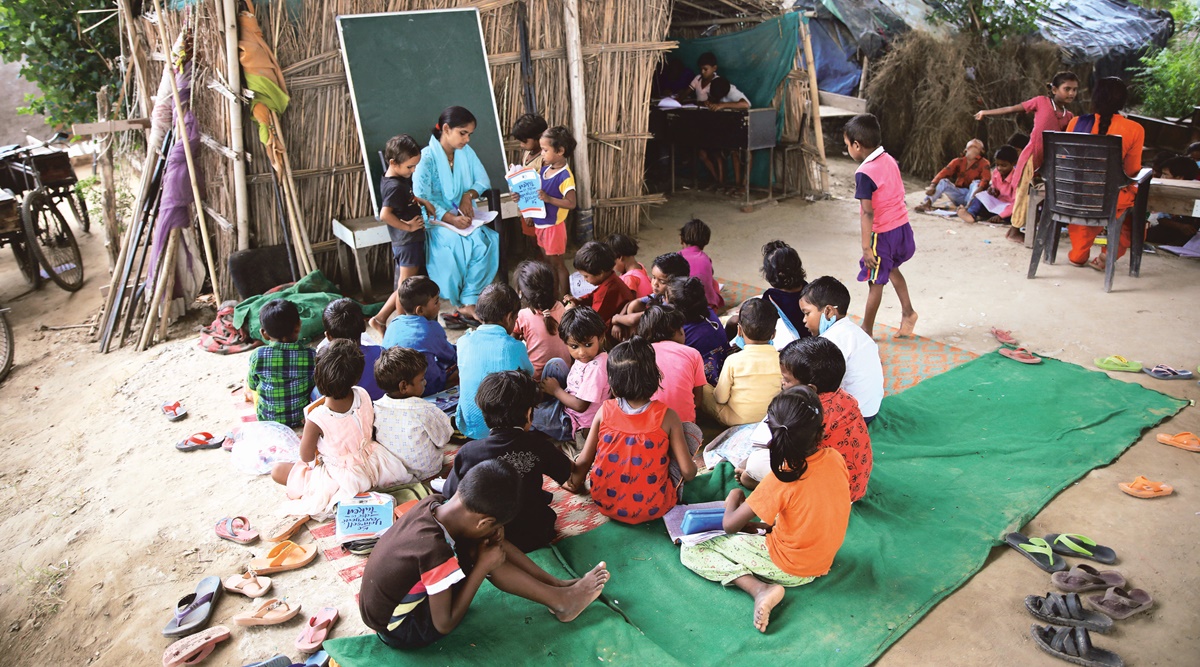
“No no, I have been going to my school every week,” says 12-year-old Khushiram when asked about not having been to school in a year.
A class VI student at a Delhi government school in Mayur Vihar Pocket IV, Khushiram lives with his family at their home on the Yamuna Khadar farmlands. While digital exchanges in some form or the other have been the predominant means of teaching-learning, Khushiram is among those children who do not have access to a smartphone. His farmer parents — neither of whom have been to school — share a basic mobile phone between them. His eldest brother does have a smartphone, but that is not shared with him.
Every Wednesday evening, a group of 4-5 children from the farmlands, including Khushiram, cycle together to their school. They meet their class teacher who hands over a set of worksheets for them to complete over the course of the week. The next Wednesday, they have to hand over the completed worksheets and collect a fresh set.
In the evenings, Khushiram sits with the worksheets on a wooden cot outside his family;s tent home. “I always do maths first. It’s my favourite subject, I’ve never had a problem with it,” he says. He glides through a simple set of exercises for adding and subtracting integers.
But he has trouble when it comes to English. He sits with a worksheet on the use of simple present tense. The beginning of the worksheet explains in English what simple present tense means and its usage, with examples on how it is used in sentences with singular and plural subjects. This is followed by exercises requiring him to choose the correct form of a verb in a sentence in the simple present tense. Khushiram, however, has difficulty comprehending sentences in English, even the simple ones in the exercises, let alone the instructional ones.
His peers with smartphones receive videos and voice notes on class WhatsApp groups explaining the content of the worksheets and how to solve them. Khushiram only receives the written text of the worksheet. “Sometimes I ask my friends with smartphones for the answers, or I watch some of the videos on their phones. Otherwise, my sir in my tuition classes helps me with them,” he says.
Like many children across the city, even though he is not going to school, Khushiram has been attending ‘tuition classes’ every day since last August in one of the many informal schools for marginalised children in Yamuna Khadar.
The ‘school’ he attends is run by Satyendra Pal and keeps him occupied till evening — the first class starts with social studies at 11 am, then science at noon, English at 3 pm, and finally maths at 4 pm. In this pandemic year, it has become his primary learning centre.
Khushiram says that a year on, he has found ways to negotiate his schoolwork but the beginning was rough. “I had gone to collect my first worksheet in July I think because I didn’t know they were being distributed till then. It was a long gap because I had not gone to school since March. I couldn’t do anything then, I couldn’t understand anything. As I kept doing them and going to tuition, they became doable,” he said.
His parents, meanwhile, say that apart from money being an issue, they are against the idea of a smartphone for their youngest son.
Expressing skepticism over the use of technology, his mother Bhagwan Dei says: “We have two more sons, one 17 and another 15. Both dropped out of school and are now working. Khushiram is studious and we are scared that if has a smartphone, he will also stop studying and will only be busy with that.”






















